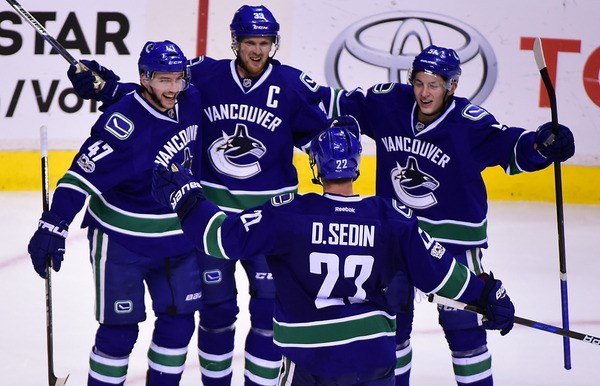The Tampa Bay Lightning led the league in power play goals last season, scoring a whopping 62 times with the man advantage. That represented over a quarter of their total goals scored last season.
The Canucks were at the opposite end of the spectrum, scoring just over half as many goals as the Lightning. Their 32 goals on the power play were a big reason why they set a franchise record for fewest goals and bettered just one team in the league: the hapless Colorado Avalanche.
If teams had the option to decline penalties like in football, it felt like the Canucks would have been better off taking that option. Too often, a strong momentum-building push by the Canucks would end up dying during a stand-still, energy-draining power play.
But the Canucks power play will be better next season and here are five reasons why:
1 | The return of Newell Brown
Part of the problem for the Canucks’ power play was personnel — the Sedins just are not the players they once were — but a big problem was coaching. The Canucks’ power play formations lacked motion, put players in positions for which they were ill-suited, and resulted in a lot of standing around, hoping for passing and shooting lanes to open up instead of creating those openings themselves.
When Willie Desjardins was fired, the Canucks let go several assistants as well and brought back Newell Brown to coach the power play. Brown oversaw some of the Canucks’ most successful years with the man advantage, particularly their league-leading power play in 2010-11 in his first year with the Canucks.
While the Canucks are unlikely to reach those heights, Brown, who favours a lot of quick puck movement and motion, should provide a boost and give the Canucks some different looks to throw at opponents’ penalty kills.
He just needs to be disabused of the notion that Brandon Sutter should be on the power play. Because...
2 | The Canucks have right-handed shots that are not Sutter
On the power play, handedness matters. It’s a lot easier to set up a one-timer or other quick shot if the player you’re passing to has his stick open to you and doesn’t have to shoot back across his body. For the Sedins, who set up on the right-side boards with their left-handed shots, this means it’s important to have right-handed shots to pass to.
In the past, they had the likes of Ryan Kesler or Sami Salo to pass to. Last season, they had Sutter, who lacks a quick release on his shot and is overall a terrible option on the power play.
Fortunately, they’ll have a couple new options for a right-handed shot on the power play in the coming season with Brock Boeser likely to make the team out of training camp and Sam Gagner signed in free agency. Gagner is a proven point-producer on the power play, but the real wild card is Boeser, who already saw some success with the Sedins on the power play in his 9-game stint last season.
Boeser had 2 goals while playing on the top power play unit with Sutter, the Sedins, and Alex Edler. Replacing Sutter with Gagner on that power play unit would be a good place to start.
3 | More power play time for Bo Horvat
Fixing the Sedin unit is one approach to improving the Canucks’ power play, but a better way might just be to give more time to Bo Horvat and the “second” unit.
The Canucks’ leaders in points per hour on the power play were Ben Hutton, Horvat, and Markus Granlund, followed by the Sedins. Those three were 6th, 7th, and 9th in power play ice time last season.
There’s no guarantee that they’ll continue to produce at that rate with more ice time, but giving Hutton, Horvat, and Granlund the chance to be the foundation of a new first unit seems like a worthwhile endeavour. The Canucks have some promising players to add to that trio as well, including Sven Baertschi, Loui Eriksson, Nikolay Goldobin, and Troy Stecher.
But also…
4 | Michael Del Zotto adds another option on the blue line
Last season, the Canucks essentially had three defencemen that made sense on the power play: Troy Stecher, Ben Hutton, and Alex Edler. They also had Philip Larsen for a little while, but it’s hard to count him.
Maybe Nikita Tryamkin or Erik Gudbranson could have been plugged in for their big shots once in a while, assuming they have big shots as we never really saw evidence of them, but the lack of options on defence essentially forced the Canucks into four-forward sets on the power play. In a pinch, Chris Tanev got power play time, but he is far from an ideal option.
The addition of Michael Del Zotto in free agency gives the Canucks another option. He produced well on the power play for the New York Rangers, but didn’t get much of an opportunity in Philadelphia. He should get another chance in Vancouver.
But really, the biggest reason why the Canucks power play will be better next season is…
5 | It can’t possibly get worse
Since 1987, when the NHL started keeping track of power play goals, the Canucks have scored fewer than 32 goals just once: the lockout-shortened 2012-13 season. They scored on a lower percentage of their power plays just once as well, in the truly atrocious 1997-98 season.
That means there’s very little room for them to get worse in the coming season. This last season was, in essence, as close to rock bottom as you can get on the power play. Next season will have to be better, because there’s basically nowhere to go but up.
Of course, now that I’ve tempted fate, the Canucks power play will almost assuredly be the worst power play in the history of the NHL.



